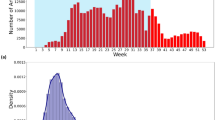Abstract
This study explores the impact of COVID-19 on Japan’s travel industry by analyzing differences before and after the pandemic through articles from the Nihon Keizai Shimbun. It employs text mining techniques like Latent Semantic Analysis (LSA) and BERT (a natural language model) to process and categorize information from newspaper titles. The analysis involves extracting nouns using MeCab, creating a frequency matrix, decomposing it with NMF for clustering, and setting topics. BERT is used for text classification, focusing on token attention weights and variance representation. The data includes articles from Nikkei Morning News pre- and post-COVID-19, specifically tagged with “Travel & Hotel,” totaling 792 articles. Analysis revealed ten topics such as vaccines, business structures, and financial results. Hierarchical clustering grouped these topics across eight clusters. Findings indicate a shift in topics post-COVID-19 towards financial impacts and business activities, highlighting tokens related to company activities and keywords associated with the pandemic. Future work aims at improving classification accuracy and leveraging data insights.
Access this chapter
Tax calculation will be finalised at checkout
Purchases are for personal use only
Similar content being viewed by others
References
Devlin, J., Chang, M.-W., Lee, K., Toutanova, K.: BERT: pre-training of deep bidirectional transformers for language understanding. CoRR, abs/1810.04805 (2018)
Le, Q., Mikolov, T.: Distributed representations of sentences and documents. In: Xing, E.P., Jebara, T. (eds.) Proceedings of the 31st International Conference on Machine Learning, Proceedings of Machine Learning Research, vol. 32 , pp. 1188–1196, Beijing, China, June 2014. PMLR (2014)
Author information
Authors and Affiliations
Corresponding author
Editor information
Editors and Affiliations
Appendices
Appendix 1: Data Code List
-
Code related to title data analysis
https://colab.research.google.com/drive/14kVhJuJSRHV0m7zCKCuPuOM0DkPcgKHQ
-
2019 Nikkei morning edition article data
https://tus.app.box.com/file/998437276219?s=e7hx3pyypf06ekyjjignhpc8b725sdd1
-
2022 Nikkei morning edition article data
https://tus.app.box.com/file/947471044518?s=bs8c424lfrckgm6o5k8bbh8vuf81axru
-
Weighted word list - positive
-
Weighted word list-negetive
Appendix 2: Attention Weight Visualization Example
In English, it is easy because only the alphabet and each word is separated, but in Japanese, kanji, hiragana, katakana, emoji and other words are connected, so it is difficult to judge where to cut. So, since the data used this time is all in Japanese, the analysis results are also attached in Japanese as is. Thank you for your understanding.
Example sentences after the coronavirus pandemic and with high \(P_{AC}\)

Example sentences before the coronavirus pandemic and with high \(P_{AC}\)

Example sentences before the coronavirus pandemic and with high \(P_{BC}\)

Example sentences after the coronavirus pandemic and with high \(P_{BC}\)

Rights and permissions
Copyright information
© 2024 The Author(s), under exclusive license to Springer Nature Switzerland AG
About this paper
Cite this paper
Yang, Y., Asahi, Y. (2024). Before and After COVID-19 Outbreak Using Variance Representation Comparative Analysis of Newspaper Articles on the Travel Hotel Industry. In: Mori, H., Asahi, Y. (eds) Human Interface and the Management of Information. HCII 2024. Lecture Notes in Computer Science, vol 14690. Springer, Cham. https://doi.org/10.1007/978-3-031-60114-9_12
Download citation
DOI: https://doi.org/10.1007/978-3-031-60114-9_12
Published:
Publisher Name: Springer, Cham
Print ISBN: 978-3-031-60113-2
Online ISBN: 978-3-031-60114-9
eBook Packages: Computer ScienceComputer Science (R0)




